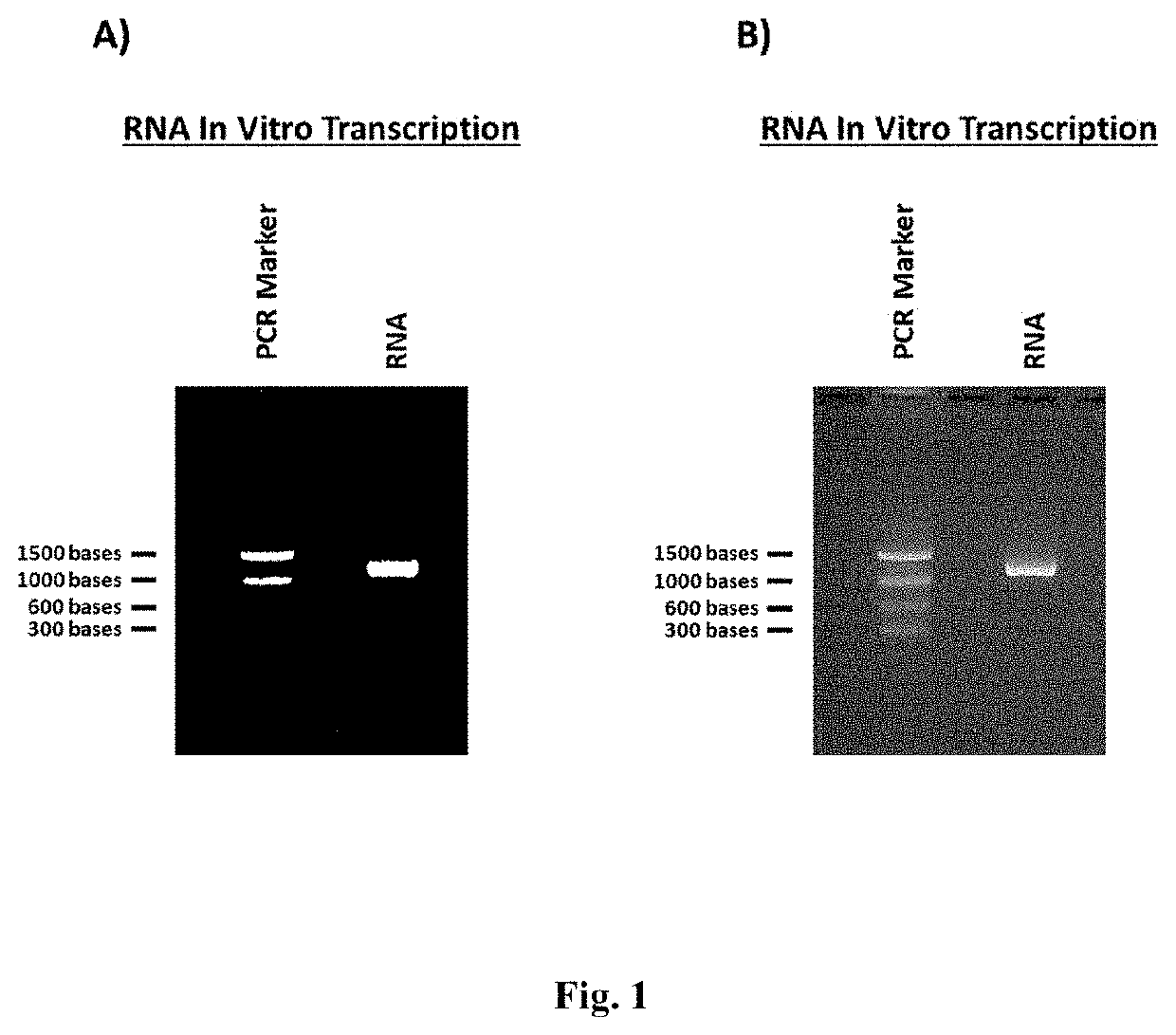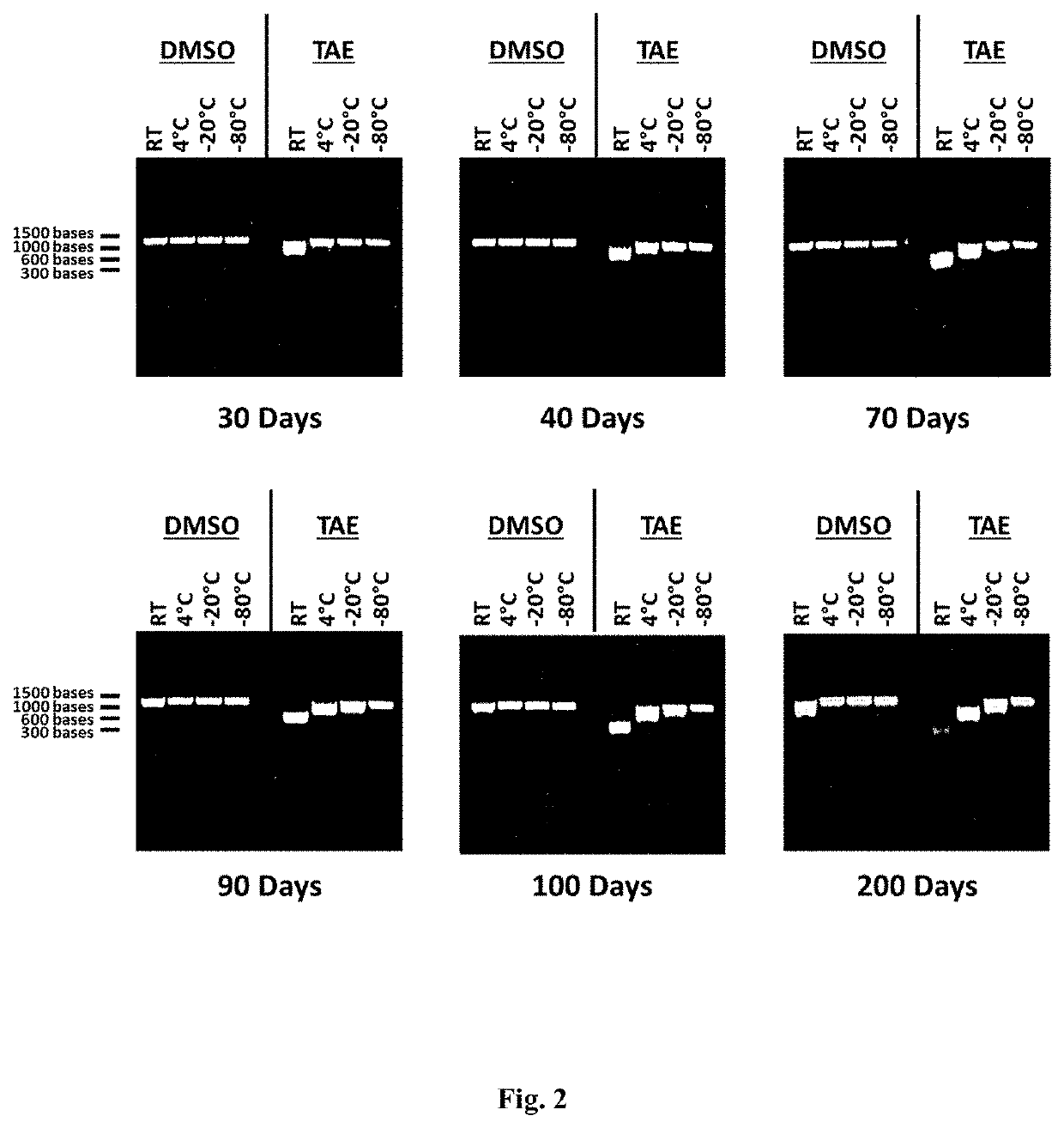RNA stabilization
- Summary
- Abstract
- Description
- Claims
- Application Information
AI Technical Summary
Benefits of technology
Problems solved by technology
Method used
Image
Examples
example 1
[0405]In Vitro Transcription
[0406]The RNA was synthesized by in vitro transcription from a linear DNA construct with an upstream T7 RNA Polymerase promoter followed by the coding sequence for gene of interest. In vitro transcription was performed using the HiScribe T7 Quick High Yield RNA Synthesis Kit (New England Biolabs, Ipswich, Mass.) according to the manufacturer's directions. Briefly, 2.5 μg template DNA was mixed with 25 μL NTP buffer mix and 5 μL T7 RNA polymerase mix. The entire reaction volume was brought to 50 μL with molecular biology grade H2O and incubated in a thermal cycler at 37° C. for 2 hrs.
[0407]Following in vitro transcription, the RNA was purified using a Monarch RNA
[0408]Cleanup Kit (New England Biolabs, Ipswich, Mass.) according to the manufacturer's directions. Briefly, 1 spin column was used for each 50 μL reaction. Following binding of the RNA to the spin column, 2 washes of 500 μL were performed and the RNA was eluted with 100 μL of molecular biology gra...
example 2
[0411]Stability of RNA at Various Temperatures
[0412]In vitro transcribed RNA was diluted approximately at a ratio of 1:10 (approximately 450 μg / mL) in either DMSO or 1× Tris-Acetate EDTA buffer (TAE). The final concentration of DMSO was approximately 90% DMSO. The final concentration of TAE was approximately Tris 40 mM, Acetate 20 mM, EDTA 1 mM, pH 8.0. Following dilution of the RNA in either DMSO or TAE, the samples were then stored at 4 different temperatures: room temperature (approximately 20-25° C.), approximately 4° C., approximately −20° C., and approximately −80° C. Samples were then analyzed by denaturing agarose gel electrophoresis as described above at selected timepoints to measure RNA degradation and the stability of the RNA samples stored in either DMSO or TAE. During storage, 10 μL of each sample was analyzed at selected timepoints by agarose gel electrophoresis to measure RNA degradation and the stability of the RNA samples stored at each temperature in either DMSO o...
example 3
[0414]Accelerated RNA Stability Testing at 60° C.
[0415]In vitro transcribed RNA was diluted approximately at a ratio of 1:10 (approximately 450 μg / mL) in different compositions containing either sodium acetate buffer (pH 5.2), or a mixture of DMSO and sodium acetate buffer (pH 5.2) as follows:
[0416]1. 50 mM Sodium Acetate, pH 5.2
[0417]2. 90% DMSO+50 mM Sodium Acetate, pH 5.2
[0418]3. 80% DMSO+50 mM Sodium Acetate, pH 5.2
[0419]4. 70% DMSO+50 mM Sodium Acetate, pH 5.2
[0420]5. 60% DMSO+50 mM Sodium Acetate, pH 5.2
[0421]6. 50% DMSO+50 mM Sodium Acetate, pH 5.2
[0422]7. 40% DMSO+50 mM Sodium Acetate, pH 5.2
[0423]8. 30% DMSO+50 mM Sodium Acetate, pH 5.2
[0424]9. −80° C.
[0425]Following dilution of each sample in each respective RNA storage environment, samples were stored at approximately 60° C. for up to 72 hours. During storage at 60° C., 10 μL of each sample was analyzed at selected timepoints by agarose gel electrophoresis to measure RNA degradation and the stability of the RNA samples in...
PUM
| Property | Measurement | Unit |
|---|---|---|
| Temperature | aaaaa | aaaaa |
| Temperature | aaaaa | aaaaa |
| Temperature | aaaaa | aaaaa |
Abstract
Description
Claims
Application Information
 Login to View More
Login to View More - R&D
- Intellectual Property
- Life Sciences
- Materials
- Tech Scout
- Unparalleled Data Quality
- Higher Quality Content
- 60% Fewer Hallucinations
Browse by: Latest US Patents, China's latest patents, Technical Efficacy Thesaurus, Application Domain, Technology Topic, Popular Technical Reports.
© 2025 PatSnap. All rights reserved.Legal|Privacy policy|Modern Slavery Act Transparency Statement|Sitemap|About US| Contact US: help@patsnap.com



